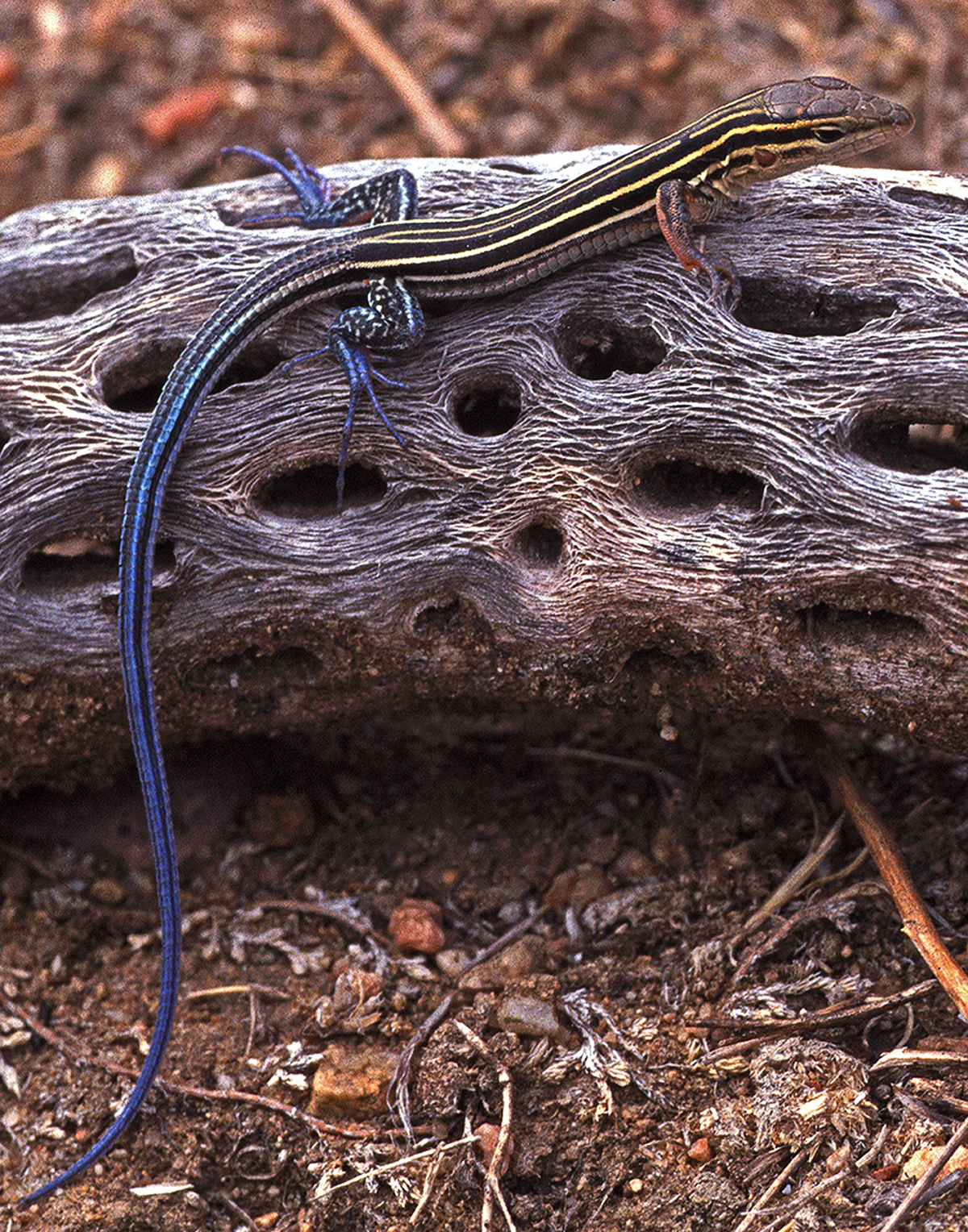Current Distribution Rangewide
Ranges from the southern edges of Orange and San Bernardino Counties, the Corona-Riverside-Colton areas of Riverside County southward through the Elsinore and Perris Basins, and through coastal and low-elevational areas of San Diego County [1]. Can be found on the coastal slope of the Peninsular Ranges-and extends from near sea level to 1040 m (northeast of Aguanga, Riverside County) [2].
Known Populations in San Diego County
Within the MSPA, occurrences have been found in MU 3 (MarronValley Mitigation Bank), MU 4 (Hanson Pond-El Monte Valley), MU 5 (Boden Canyon), and MU 6 (Rancho La Costa HCA).
List Status
None.
Habitat Affinities
Occurs primarily on coarse soils in open coastal sage scrub vegetation [3, cited in 1]. Also inhabits chamise-redshank chaparral, mixed chaparral, and valley-foothill hardwood habitats [4]. Associated with the presence of some perennial plants such as buckwheat (Erigonum fasciculatum), low, open chamise (Adenostoma fasciculatum), and white sage and black sage (Salvia apiana and S. mellifera) [1] due to its food source, termites [5], and its necessary requirement of a perennial plant as a food base [6, cited in 2]. Occurs along the edge of open, dry, riparian areas, along trails, along dirt roads, and in areas of light off-road vehicle use [1].
Taxonomy and Genetics
This taxon is morphologically distinct [7] and has never been confused with any other taxon [2].
Seasonal Activity
Emerge from hibernation in February or March [6, cited in 2] through April [8]. May be active in every month of the year whenever it is sufficiently warm [1;6, cited in 2;8]. Adults especially active in the spring and less active in the fall [1]. Diurnal [8]. Daily activity occurs within a narrow range of substrate temperatures (36.3°C-41.0°C), clearly avoiding high midday temperatures [6, cited in 2;8;9]. Adults enter into hibernation late July to late September [9], with immature lizards entering hibernation late December [6, cited in 2;8].
Life History/Reproduction
Breeding season lasts from May through mid-July [10;11]. Sexually maturity reached in 1 year, but most individuals, especially females, require 2 years to become sexually mature [12]. Females deposit two or three moderate-sized, leathery-shelled eggs in June or July in an unknown location. Mean clutch is small (2.3 eggs). Incubation lasts from 50 to 55 days [10]. Hatchlings emerge from August through October [1]. Longevity is unknown [2].
Diet and Foraging
Feeds primarily on termites [5]. Will feed on other insects such as spiders, beetles, and grasshoppers during the late summer [6, cited in 2]. Forages actively on the surface and scratches through surface debris [4]. Regularly stops movement momentarily to probe for food within leaf litter, shallow burrows, and loose soil [9].
Dispersal
No migration [4]. Home range of 6 males averaged 0.07 acres, while that of 5 females averaged 0.15 acres. Extensive home range of both females and males overlap [13] and probably suggests no territorial behavior [4].
Threats
Threatened mainly due to habitat loss [1]. A considerable amount of its habitat has been destroyed and fragmented by urban and agricultural development in southern California [2].
Literature Sources
[1] Brattstrom, B. H. 2000. The Range, Habitat Requirements, and Abundance of the Orange-throated Whiptail, Cnemidophorus hyperythrus beldingi. Bulletin of the Southern California Academy of Sciences 99(1): 1-24.
[2] Jennings, M. R. and M. P. Hayes. 1994. Amphibian and Reptile Species of Sspecial Concern in California. Rancho Cordova, CA: California Department of Fish and Game, Inland Fisheries Division.
[3] McGurty, B.M., 1980. Preliminary Review of the Status of the San Diego Horned Lizard, Phrynosoma coronatum blainvellei and the Orange-throated Whiptail, Cnemidophorus hyperythrus beldingi. Contract Report to California Department of Fish and Game.
[4] Morey, S. 2000. Orange-throated Whiptail.Duke, R. and J. Harris, eds. California's Wildlife. Vol. I-III. California Department of Fish and Game, Sacramento, California.
[5] Bostic, D. L. 1966. Food and Feeding Behavior of the Teiid Lizard, Cnemidophorus hyperythrus beldingi. Herpetologica 22(1): 23-31.
[6] Rowland, S. D. 1993. Activity, Behavior, Ecology, and Home Range of the Orange-throated Whiptail, Cnemidophorus hyperythrus beldingi Cope.
[7] Walker, J.M. and Taylor, H.L., 1968. Geographical variation in the teiid lizard Cnemidophorus hyperythrus. I. The caeruleus-like subspecies. American Midland Naturalist, pp.1-27.
[8] Bostic, D. L. 1966. Thermoregulation and Hibernation of the Lizard, Cnemidophorus hyperythrus beldingi (Sauria: Teiidae). The Southwestern Naturalist, 275-289.
[9] Grismer, L. L. 2002. Amphibians and Reptiles of Baja California, including its Pacific Islands and the Islands in the Sea of Cortes.University of California Press.
[10] Bostic, D. L. 1966. A Preliminary Report of Reproduction in the Teiid Lizard, Cnemidophorus hyperythrus beldingi. Herpetologica 22(2): 81-90.
[11] Atsatt, S. R. 1913. The Reptiles of the San Iacinto Area of Southern California.
[12] Bostic, D. L. 1964. The Ecology and Behavior of Cnemidophorus hyperythrus beldingi Cope(Sauria: Teiidae). Master's thesis, San Diego State College.
[13] ―. 1965. Home Range of the Teiid Lizard, Cnemidophorus hyperythrus beldingi." The Southwestern Naturalist, 278-281.


